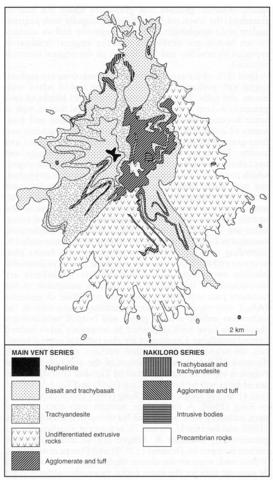stripes
The Moroto volcano covers an area of approximately 25x15 km and rises to just over 3000 m, about 1500 m above the surrounding plains. Although the constructional surfaces of the volcano are largely untouched erosion has removed the core so that it can be seen to be built principally of lavas and stratified agglomerates, which have been divided by Varne (1967) into four phases. He also recognised six intrusive centres, the largest of which forms the main vent of the volcano. Varne (1968) distinguises two igneous series: (1) alkali olivine basalt - trachyandesite - phonolite and (2) olivine melanephelinite - melanephelinite and nephelinite - felsic nephelinite. The basaltic rocks occur as flows, dykes, small intrusive bodies and blocks in agglomerates. They may be porphyritic, when olivine, pyroxene, plagioclase and opaque minerals form phenocrysts; the groundmass comprises clinopyroxene, andesine, alkali feldspar and opaques. Trachyandesites contain oligoclase and clinopyroxene; basaltic hornblende, olivine, anorthoclase, nepheline, apatite and opaque minerals may all occur as phenocrysts, and analcime can be present in the groundmass. Varne's (1968) phonolitic types all contain >15% normative ne, but nepheline may not be present modally. Nepheline, clinopyroxene and magnetite may be phenocrystal with alkali feldspar, iron-rich olivine, sodalite and analcime also present in the groundmass. Hytonen (1959) described phonolites containing in addition aegirine-augite and a brown amphibole. Trachytes also occur and these are similar to the phonolites but free of nepheline. The olivine melanephelinites invariably contain olivine, clinopyroxene and opaque minerals as phenocrysts, and rarely those of nepheline, set in a glassy groundmass, the phenocrysts forming as much as 50% of the rock, pyroxene being the most abundant. The normal diopsidic pyroxene may be altered to aegirine around nepheline-filled cavities. Accessory biotite and sodalite are sometimes present. These rocks pass into variably porphyritic and aphanitic melanephelinites and nephelinites in which olivine does not occur, the pyroxene is usually aegirine-augite forming long prisms and nepheline forms isolated prisms and glomeroporphyritic aggregates. Analcime, opaques, and rarely amphibole occur in the groundmass. Felsic nephelinites, which have a colour index of <10, are rare. Aegirine-augite, nepheline and titanite form phenocrysts and alkali feldspar may be present in the groundmass. The principal rock type in the main vent is ijolite which forms a body of about 1x05 km. Detailed petrography and a few rock and mineral analyses are available in Hytonen (1959). Varne (1968) gives rather more rock analyses and develops a petrogenetic model for the nephelinitic rocks based on incongruent melting of pargasitic amphibole, which is found in intrusive vent breccias, and which has a similar composition to the rocks. Bell and Powell (1970) give Sr isotope data and Rb and Sr abundances for two phonolites.
BELL, K. and POWELL, J.L. 1970. Strontium isotopic studies of alkalic rocks: the alkalic complexes of eastern Uganda. Bulletin of the Geological Society of America, 81: 3481-90.BISHOP, W.W., MILLER, J.A. and FITCH, F.J. 1969. New potassium-argon age determinations relevant to the Miocene fossil mammal sequence in east Africa. American Journal of Science, 267: 669-99.FLEUTY, M.J. 1968. Explanation of the geology of Sheet 27 (Moroto). Report, Geological Survey of Uganda, 13: 1-65.HYTONEN, K. 1959. On the petrology and mineralogy of some alkaline volcanic rocks of Toror Hills, Mt. Moroto, and Morulinga in Karamoja, northeastern Uganda. Bulletin de la Commission Geologique de Finlande, 184: 75-132.MACDONALD, R. 1961. Explanation of the geology of Sheet 36 (Nabilatuk). Report, Geological Survey of Uganda, 5: 1-57.VARNE, R. 1967. The growth of the Moroto volcano, eastern Uganda. Bulletin Volcanologique, 31: 163-74.VARNE, R. 1968. The petrology of Moroto Mountain, eastern Uganda, and the origin of nephelinites. Journal of Petrology, 9: 169-90.

